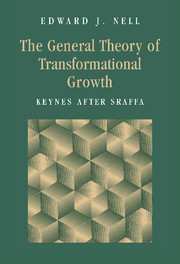Book contents
- Frontmatter
- Contents
- Preface
- Acknowledgments
- Part I History or equilibrium?
- Part II Method and approach: the active mind
- Part III Money and the Golden Rule
- PART IV The wage-profit trade-off
- 7 The Classical system: the Golden Rule, labor, and the wage-profit trade-off
- 8 The Classical system: gravitation and market adjustment
- 9 Cycles and growth: market adjustment in Craft conditions
- Part V Investment and Mass Production
- Part VI Money and fluctuations in the modern economy
- Conclusions
- Bibliography
- Index
9 - Cycles and growth: market adjustment in Craft conditions
Published online by Cambridge University Press: 21 January 2010
- Frontmatter
- Contents
- Preface
- Acknowledgments
- Part I History or equilibrium?
- Part II Method and approach: the active mind
- Part III Money and the Golden Rule
- PART IV The wage-profit trade-off
- 7 The Classical system: the Golden Rule, labor, and the wage-profit trade-off
- 8 The Classical system: gravitation and market adjustment
- 9 Cycles and growth: market adjustment in Craft conditions
- Part V Investment and Mass Production
- Part VI Money and fluctuations in the modern economy
- Conclusions
- Bibliography
- Index
Summary
In both the Artisan era and in the time of Craft-based factories prices tended to be more flexible than output or employment. The cycle showed itself in prices and real wages, which tended to vary inversely to employment. Cycles in the early period of the Craft economy tend to converge toward a normal position, which is periodically disrupted by financial crises, resulting in a Slutsky-Frisch dynamic pattern. But price fluctuations put great pressure on business. By developing greater flexibility in production, output and employment – hence running costs – could be varied in response to sales, making it possible to keep prices stable, thus protecting profits, but leading to a different pattern of market adjustment. But the necessary technological changes – mechanization – lead to changes in the proportions of the sectors, in particular to an outflow of labor from agriculture.
Initially, the ability to vary employment and output was limited, and still costly, requiring price changes to make it worthwhile. However, this ability, even if limited, was in the interests of firms individually. But developing it brought changes in the way markets adjusted. Limited flexibility in adjusting output and employment characterizes the Marshallian adjustment process. Deviations of employment from the “normal” position will increase unit costs.
As we shall see, further development, resulting in Mass Production, greatly increased the ability to vary output and employment, without affecting unit costs, but it made the system as a whole more unstable.
- Type
- Chapter
- Information
- The General Theory of Transformational GrowthKeynes after Sraffa, pp. 410 - 464Publisher: Cambridge University PressPrint publication year: 1998



